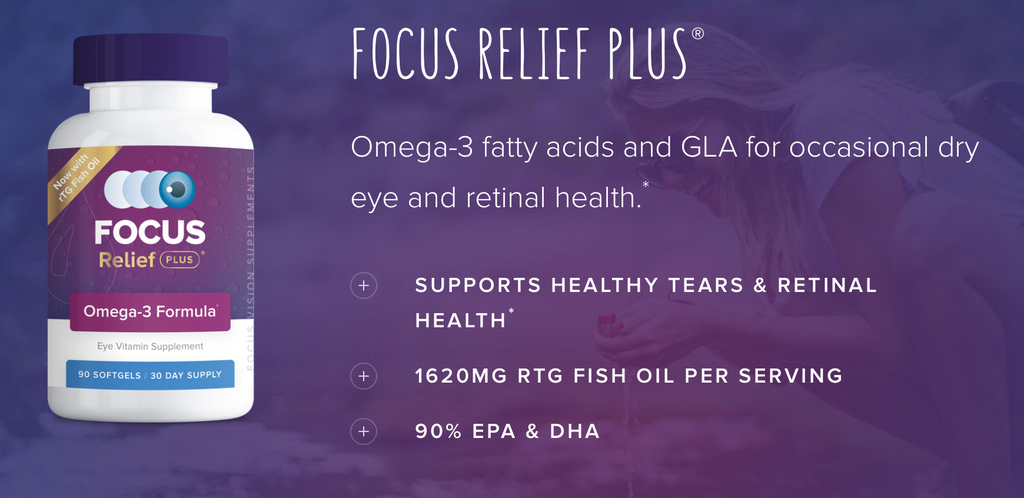Focus Relief Plus Omega-3 Fatty Acids and GLA For Eye Support - Softgels
Focus Relief Plus Omega-3 Fatty Acids and GLA For Eye Support - Softgels
Share
SKU:FV-91
50 in stock
Couldn't load pickup availability
We accept



Omega-3 fatty acid intake has been shown to play a critical role in helping support healthy tears1 and is recommended as part of an effective treatment plan for occasional dry eye.2,*
In a study published in JAMA Ophthalmology, Omega-3 fatty acid intake was also associated with a decreased risk of developing sight-threatening diabetic retinopathy for individuals with Type 2 Diabetes.3
Focus Relief Plus® provides 1620mg of re-esterified triglyceride (rTG) Omega-3 fatty acids per day with over 90% EPA and DHA, a higher concentration than other leading supplements. It also contains 75mg of GLA, which when combined with EPA/DHA, can play an important role in reducing inflammation.3 All of this is provided in a compact and easy-to-swallow softgel.
Ask your eye doctor if Focus Relief Plus® is the best choice for you.
Suggested Use: As a dietary supplement, take three (3) softgels daily with a meal.
Ingredients
Omega 3 Fish Oil, Gamma Linolenic Acid

FAQ's
Q: How long does the bottle last and how many do I take per day?
A: 1 bottle contains 90 softgels, lasting 30 days when taken 3 times per day. Patients should always consult their physicians on instructions.
Q: Are Focus Vitamins safe for my patients?
A: Every product is exclusively produced in NSF certified and FDA audited facilities for cGMP (Good Manufacturing Practice) compliance. Numerous consumer advocate and public health organizations, including the Council for Responsible Nutrition and Consumer Reports, recommend patients seek NSF or similar third-party certification prior to purchase. (Interlandi, 2016)
We go beyond industry requirements by conducting and approving a certification of analysis (COA) prior to distribution for every active ingredient, on every lot, every time. Lots are also tested by third party labs to ensure our manufacturing claims are correct, but also validate stability and expiration dating. Expiration dating for the new Focus Relief Plus® will be 2 years from date of manufacture and will be printed on the bottle.
Interlandi, J. (2016, September). Supplements: A Complete Guide to Safety. Consumer Reports, pp. 20-33.
Q: Why 3 times per day?
A: Focus Relief Plus® was designed for three doses per day to allow patients to conveniently take the supplement with meals, preferably high in healthy fats. Clinical studies have shown that absorption improve three-fold when taken with high-fat meals. (Lawson LD H. B., 1988)
Lawson LD, H. B. (1988). Absorption of eicosapentaenoic acid and docosahexaenoic acid from fish oil triacylglycerols or fish oil ethyl esters co-ingested with a high-fat meal. Springville: Biochemical and Biophysical Research Communications.
Q: Who should take Focus Relief Plus®?
A: Those suffering from occasional dry eye symptoms, sourcing from a number of environmental, genetic, and post-operative factors. Focus Relief Plus contains fish oil concentrates. These fish oils are in rTG (re-esterified triglyceride) form, containing 1080mg of EPA and 420mg of DHA per day—levels shown to play a critical role in helping produce healthier tears. (Bhargava, 2013) (Macsai, 2008) (Kangari H, 2013)
Additionally, NEI has commented and supported the conclusions on a large-scale study that shows benefit to those type 2 diabetic patients who may be at risk of diabetic retinotopy (Chew, 2017). This study showed:
“In middle-aged and older individuals with type 2 diabetes, intake of at least 500 mg/d of dietary LCω3PUFA, easily achievable with 2 weekly servings of oily fish, is associated with a decreased risk of sight-threatening DR. Our results concur with findings from experimental models and the current model of DR pathogenesis.” (Sala-Vila A 2016)
Bhargava, K. K. (2013). A randomized controlled trial of Omega-3 fatty acids in dry eye syndrome. Santosh Medical College and Hospital, Department of Ophthalmology. Ghaziabad: Int J Ophthalmol.
Macsai, M. (2008). The role of Omega-3 dietary supplementation in blepharitis and meibomian gland dysfunction (an AOS thesis). Northwestern University Feinberg School of Medicine, Department of Ophthalmology. Chicago: Tans Am Opthalmol Soc.
Kangari H, E. M.-B. (2013). Short-term consumption of oral Omega-3 and dry eye syndrome. Shahid Beheshti University of Medical Sciences, Department of Optometry. Tehran: Ophthalology. doi:10.1016/j.ophtha.2013.04.006
Chew (2017). Dietary Intake of Omega-3 Fatty Acids From Fish and Risk of Diabetic Retinopathy
Sala-Vila A, Díaz-López A, Valls-Pedret C, et al. Dietary Marine ω-3 Fatty Acids and Incident Sight-Threatening Retinopathy in Middle-Aged and Older Individuals With Type 2 DiabetesProspective Investigation From the PREDIMED Trial. JAMA Ophthalmol. 2016;134(10):1142–1149. doi:10.1001/jamaophthalmol.2016.2906


